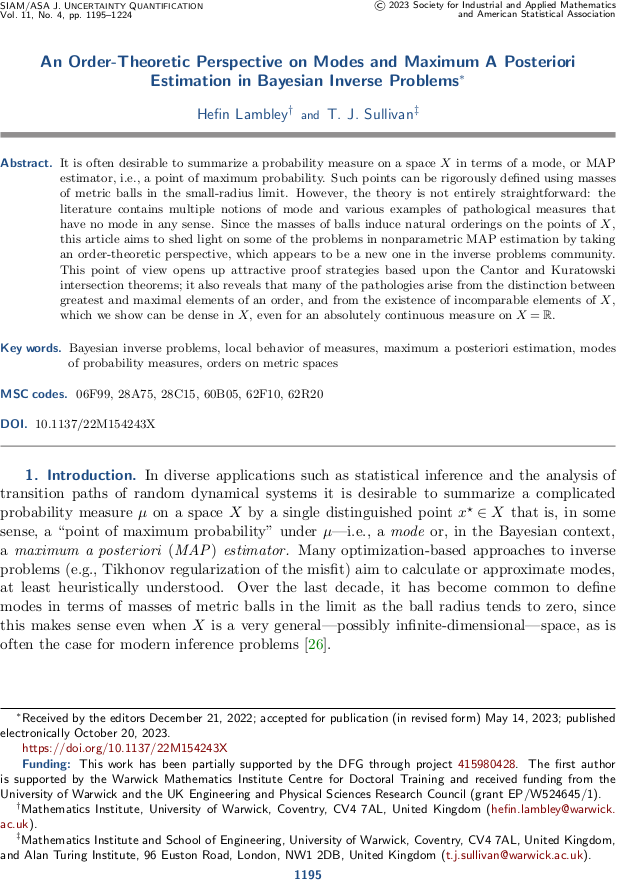#order-theory

Order-theoretic perspectives on MAP estimation in SIAM/ASA JUQ
The final version of “An order-theoretic perspective on modes and maximum a posteriori estimation in Bayesian inverse problems” by Hefin Lambley and myself has just appeared online in the SIAM/ASA Journal on Uncertainty Quantification.
On a heuristic level, modes and MAP estimators are intended to be the “most probable points” of a space \(X\) with respect to a probability measure \(\mu\). Thus, in some sense, they would seem to be the greatest elements of some order on \(X\), and a rigorous order-theoretic treatment is called for, especially for cases in which \(X\) is, say, an infinite-dimensional function space. Such an order-theoretic perspective opens up some attractive proof strategies for the existence of modes and MAP estimators but also leads to some interesting counterexamples. In particular, because the orders involved are not total, some pairs of points of \(X\) can be incomparable (i.e. neither is more nor less likely than the other). In fact we show that there are examples for which the collection of such mutually incomparable elements is dense in \(X\).
H. Lambley and T. J. Sullivan. “An order-theoretic perspective on modes and maximum a posteriori estimation in Bayesian inverse problems.” SIAM/ASA Journal on Uncertainty Quantification 11(4):1195–1224, 2023.
Published on Friday 20 October 2023 at 09:00 UTC #publication #modes #order-theory #map-estimators #lambley #juq

Order theory and MAP estimation
Hefin Lambley and I have just uploaded a preprint of our latest article, “An order-theoretic perspective on modes and maximum a posteriori estimation in Bayesian inverse problems”, to the arXiv. On a heuristic level, modes and MAP estimators are intended to be the “most probable points” of a space \(X\) with respect to a probability measure \(\mu\). Thus, in some sense, they would seem to be the greatest elements of some order on \(X\), and a rigorous order-theoretic treatment is called for, especially for cases in which \(X\) is, say, an infinite-dimensional function space. Such an order-theoretic perspective opens up some attractive proof strategies for the existence of modes and MAP estimators but also leads to some interesting counterexamples. In particular, because the orders involved are not total, some pairs of points of \(X\) can be incomparable (i.e. neither is more nor less likely than the other). In fact we show that there are examples for which the collection of such mutually incomparable elements is dense in \(X\).
Abstract. It is often desirable to summarise a probability measure on a space \(X\) in terms of a mode, or MAP estimator, i.e. a point of maximum probability. Such points can be rigorously defined using masses of metric balls in the small-radius limit. However, the theory is not entirely straightforward: the literature contains multiple notions of mode and various examples of pathological measures that have no mode in any sense. Since the masses of balls induce natural orderings on the points of \(X\), this article aims to shed light on some of the problems in non-parametric MAP estimation by taking an order-theoretic perspective, which appears to be a new one in the inverse problems community. This point of view opens up attractive proof strategies based upon the Cantor and Kuratowski intersection theorems; it also reveals that many of the pathologies arise from the distinction between greatest and maximal elements of an order, and from the existence of incomparable elements of \(X\), which we show can be dense in \(X\), even for an absolutely continuous measure on \(X = \mathbb{R}\).
Published on Monday 26 September 2022 at 09:00 UTC #preprint #modes #order-theory #map-estimators #lambley